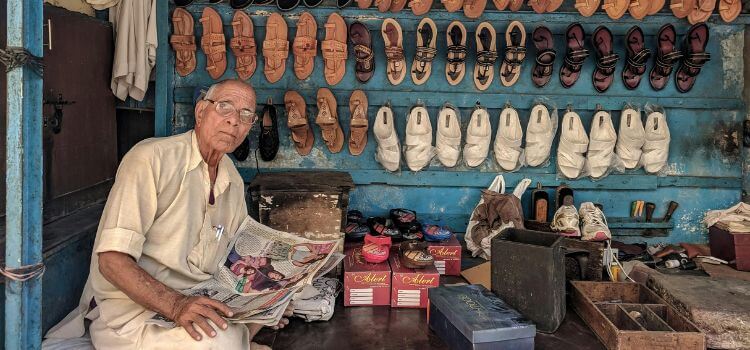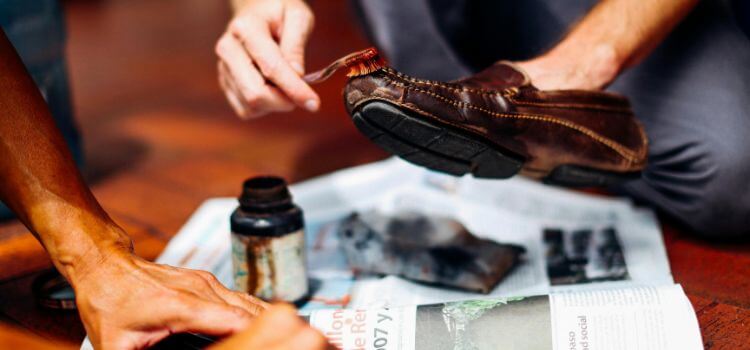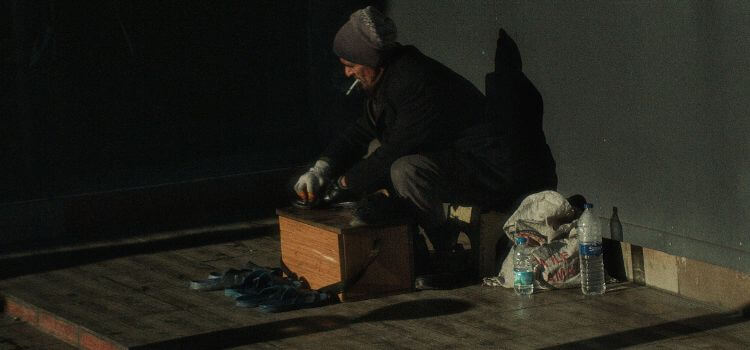To clean work shoes, brush away excess dirt and wipe them down with a damp cloth. For stubborn stains, use a gentle cleanser and let them air dry.
Maintaining a clean pair of work shoes enhances their appearance and extends their lifespan. Many may overlook this task, yet it is essential for both hygiene and professionalism. Dirty shoes can harbour bacteria and present a shabby image, which is especially critical for jobs requiring a sharp appearance.

An accurate cleaning routine removes accumulated dirt, prevents odour, and keeps the material in good condition. It is important to tailor your cleaning technique to the shoe material, whether it’s leather, synthetic, or fabric, ensuring it receives the care it requires. This task doesn’t have to be time-consuming; a regular, quick clean can significantly reduce grime buildup. Clean work shoes reflect a conscientious and detail-oriented employee, making a positive impression in any workplace.
Introduction To The Importance Of Clean Work Shoes
Maintaining clean work shoes is essential for professional appearance and hygiene standards. This guide walks you through the steps to effectively clean your footwear, ensuring longevity and optimal condition.
Clean work shoes are more than just footwear. They symbolize professionalism and attention to detail, leave a lasting impression on clients and colleagues, and contribute to personal hygiene and comfort. In any industry, maintaining clean work shoes is fundamental. It reflects your commitment to workplace standards and personal image.
First Impressions Matter: The Role Of Shoe Appearance
The impact of a well-maintained shoe cannot be overstated. Your boots can speak volumes before you even utter a word. Impeccable shoes set a tone of professionalism. They tell a story of your dedication to your role. Consider the message your shoes are sending at your workplace.
Hygiene And Longevity: Why Regular Cleaning Is Essential
Work shoes encounter numerous contaminants, including dirt, spills, and sweat. Neglect can lead to unpleasant odours and deterioration. Regular cleaning eliminates bacteria, increases shoe life, and keeps feet in top condition. A routine shoe care practice is a must for anyone serious about their job.
Identifying Your Work Shoe Material
Identifying the material of your work shoes is the first crucial step before you dive into cleaning them. Different materials require different cleaning methods to maintain their integrity and appearance. By understanding what your shoes are made of, you set the stage for effective and safe cleaning that will keep your shoes in top condition for longer. Let’s explore the main types of materials and how to approach their care.
Leather, Suede, Or Synthetic: Knowing Your Shoe Material
The type of material your work shoes are made of will dictate the cleaning supplies and techniques you’ll use. Leather shoes need care that keeps them moisturized and prevents cracking. Suede, with its delicate texture, requires gentle cleaning and special attention to maintain its nap. Synthetic materials, on the other hand, can often withstand more vigorous cleaning. Here’s a quick guide to help you identify your shoe material:
| Material | Characteristics |
| Leather | Smooth, durable, slightly flexible |
| Suede | Soft, textured, matte finish |
| Synthetic | Man-made, often shiny, uniformity in texture |
Material-Specific Cleaning Techniques: A Primer
Once you’ve pinpointed the type of material, you can move on to material-specific cleaning techniques. Here’s a primer to get you started:
- Leather: Use a soft cloth and cleaner designed for leather. Apply a conditioner post-cleaning.
- Suede: Employ a suede brush to lift dirt and a cleaner formulated for suede to tackle stains.
- Synthetic: Wipe with a damp cloth and gentle soap, rinse, and let air dry.
Remember, before applying any cleaning method, always perform a spot test in an inconspicuous area to ensure the cleaner does not damage the shoe material.
Preparation Steps Before Cleaning
Before cleaning your work shoes, start with the essential preparation steps. Proper preparation is key to ensuring a thorough clean without damaging your boots.

Gather Your Cleaning Tools And Supplies
Assembling the right tools and materials is your first step. Gather everything you need to avoid mid-clean disruptions. Below is a list of items to collect:
- Soft-bristled brush – for gentle scrubbing
- Mild detergent or shoe cleaner – cleans without harm
- Bucket or basin – fills with water and detergent
- Sponge or cloth – helps apply the soap
- Towel – dries shoes after washing
Remove Dirt And Debris: The Preliminary Clean
Begin by removing loose dirt to prevent scratching. Take off excess mud or grit from your work shoes with these steps:
- Tap shoes together to shake off debris
- Use a soft-bristled brush to sweep away the remaining dirt
- Wipe the surface with a dry cloth
Address scuff marks or ingrained dirt by targeting those areas with additional brushing.
Leather Shoes: Step-by-step Cleaning Guide
Leather shoes require care to ensure they last longer and look better. A routine clean keeps them in top shape. Follow these steps to have your leather shoes shine.
Conditioning Leather: Keeping It Soft And Durable
Clean shoes with a soft brush or cloth first. This removes dirt and grime.
- Choose a good-quality leather conditioner.
- Apply a small amount using a soft cloth.
- Rub it in a circular motion.
- Let the conditioner absorb for about 30 minutes.
- Buff after to a soft glow.
This keeps the leather supple and crack-free. Condition your shoes every few months.
Polishing Tips For A Professional Finish
Polishing gets shoes looking sharp and professional. It protects leather, too.
Select a polish that matches your shoes. Apply a small amount with a soft cloth or brush. Use circular strokes. Allow the polish to dry. Buff to shine.
- Use tiny polish amounts for even coverage.
- Let it dry before a second coat if needed.
- Alternate with clear polish for extra shine.
- Finish with a horsehair brush or soft cloth.
Polish monthly or before special events. Regular care keeps leather shoes looking new.
Suede Shoes: Tackling The Challenges
Suede is a delicate material that demands special care. Shoes made of suede add a touch of elegance to any outfit. Yet, they can be a challenge to keep clean. Whether it’s dust, mud, or accidental spills, suede shoes need attention to maintain their classic look. Your work shoes go through a lot, but with the right techniques, they can stay looking fresh. Let’s explore how to keep your suede shoes in top condition.
Brushing Techniques For Suede Texture Maintenance
Consistent brushing keeps suede shoes looking new.
- Choose a specialized suede brush.
- Brush gently in one direction.
To lift the nap, use a back-and-forth motion. Keep the bristles soft to avoid damage. Regular brushing after each wear will prevent dirt buildup.
Stain Removal Solutions For Stubborn Spots
Accidental stains don’t have to be permanent.
- Address spills immediately.
- Blot gently with a clean cloth.
For tough stains, consider a suede eraser. Rub gently until the mark fades. Suede shampoo can also tackle spots. Apply according to instructions and then let dry. Remember to brush the suede after drying to revive the texture.
Synthetic And Fabric Shoes: Effective Cleaning Methods
Keeping synthetic and fabric work shoes clean is crucial. These materials need special care. Learn how to maintain them properly. Your shoes will look better and last longer.

Machine Washing: Is It Safe For Your Shoes?
Check the label on your shoes first. Some can go in the washing machine, and others cannot. This step is critical.
- Remove laces and insoles.
- Place shoes in a mesh bag.
- Use cold water and a gentle cycle.
- Always air dry. Never use a dryer.
| Shoe Type | Machine Safe? |
| Synthetics | Often, check the label |
| Fabric | Sometimes, check the label |
Hand Washing: Detail-oriented Cleaning
Hand Washing: Detail-oriented Cleaning
Hand washing suits all shoes. It protects them from damage. You control the cleaning process.
- Mix warm water with mild detergent.
- Use a soft brush for scrubbing.
- Focus on dirty areas.
- Rinse with a damp cloth.
- Stuff with paper to maintain shape.
- Air dry away from direct sunlight.
Drying Your Work Shoes Properly
After cleaning your work shoes, drying them properly is key to maintaining their shape and integrity. The way you dry your footwear can prolong their life and ensure they’re ready for another day on the job.
Avoiding Heat Damage During Drying
High temperatures can damage shoe materials. Follow these steps to avoid heat damage:
- Never place shoes directly in front of heaters or fires.
- Keep shoes at room temperature in a well-ventilated area.
- Avoid direct sunlight as it can fade colours and weaken the material.
Speeding Up The Drying Process Without Compromise
To speed up the drying process safely, try these tips:
- Use absorbent towels to pat down excess moisture.
- Stuff newspaper inside to absorb water and maintain shape.
- Consider a fan to circulate air around the shoes without applying heat directly.
- Switch out the newspaper every few hours for faster drying.
Maintaining Clean Shoes With Daily Practices
Maintaining Clean Shoes with Daily Practices is essential for anyone who spends a lot of time in work shoes. By adopting a few daily habits, you can keep your footwear looking fresh. This not only enhances the aesthetic appeal but also extends the life of your shoes. Let’s dive into some effective ways to preserve your shoes on a daily basis.

Storage Tips To Prevent Dust And Mold
Proper storage is key to preventing dust and mould. Keep these tips in mind:
- Use a shoe rack: Elevates shoes, allowing air to circulate.
- Avoid damp areas: Choose a dry spot to hinder mould growth.
- Use silica gel packets: They absorb moisture.
- Cover: Cloth bags can shield shoes from dust.
Regular Spot Cleaning: A Habit That Pays Off
Spot cleaning after each use can keep tough stains at bay:
- Wipe off dirt: Use a soft cloth or a brush.
- Address spills immediately: Quick action can prevent permanent stains.
- Mild detergent: For tougher spots, a gentle cleaner works wonders.
- Dry properly: Let shoes air-dry away from direct heat.
Solving Common Problems When Cleaning Work Shoes
Keeping your work shoes clean can often feel like a battle against the elements and the tough worksite conditions. However, proper care can ensure they last longer and stay comfortable. Discover solutions to some of the most common cleaning challenges faced by work shoe owners.
Salt Stains And Water Damage: Specialized Care
Salt stains and water damage on work shoes can prove tricky. But with the right approach, you can tackle them head-on:
- Wipe your shoes with a soft, damp cloth to remove loose salt and dirt.
- Mix a solution of equal parts water and white vinegar.
- Gently apply the mixture to stained areas using a soft cloth.
- Let your shoes air-dry away from direct heat.
- After drying, condition the leather to restore its natural oils.
Odor Elimination: Freshening Up Smelly Shoes
Work shoes can start smelling unpleasant due to constant use. Keep them fresh with these steps:
- Remove insoles and wash them separately if they’re washable.
- Sprinkle baking soda inside your shoes and let it sit overnight.
- Vacuum the baking soda out the next morning.
- For an extra fresh scent, place dryer sheets in each shoe after wearing.
TIP: Be consistent with these methods to maintain a fresh-smelling pair of work shoes.
When To Call The Professionals
Keeping work shoes clean boosts their longevity and maintains hygiene. Sometimes, despite our best efforts, DIY cleaning needs to be improved. In such cases, professional shoe cleaners take over.
Deciphering When Diy Cleaning Isn’t Enough
Work shoes face tough stains, odours, and wear. Recognize the signs when your efforts might not suffice:
- Persistent Stains: Stains that survive your cleaning ritual.
- Material Care: Leather or suede may require special treatment.
- Odour Removal: Home remedies fail to freshen up the shoes.
- Damage: Tears or loose soles might need a professional’s touch.
The Benefits Of Professional Shoe Care Services
Embrace the advantages that come with expert shoe maintenance. Here’s what you can expect:
| Benefits | Details |
| Expertise | Pros have the right tools and knowledge. |
| Materials | They use premium products for the best results. |
| Longevity | Professionals help extend your shoes’ lifespan. |
| Time-saving | Saves time and effort while the pros take care of it. |
Conclusion And Final Tips
Welcome to the wrap-up of our comprehensive guide on cleaning work shoes.
Remember, proper care extends your shoes’ life and keeps them looking sharp.
Recap Of Best Practices For Shoe Maintenance
Let’s quickly review essential tips to maintain your shoes:
- Remove dirt after every use.
- Use proper cleaning agents for different materials.
- Dry shoes properly to avoid bad smells and damage.
- Invest in maintenance tools like brushes and protectant sprays.
- Store shoes in a cool, dry place to keep them in prime condition.
Developing A Cleaning Routine: The Path To Longevity
Maintaining your shoes takes regular effort. Create a simple weekly routine:
| Day | Task |
| Monday | Quick wipe |
| Wednesday | Deep clean |
| Friday | Conditioning |
This routine keeps shoes neat and lengthens their life.
Stick to this plan, and your work shoes will always be ready!
Frequently Asked Questions For How To Clean Work Shoes
How Do You Clean Working Shoes?
Remove excess dirt with a brush. Use mild soap and water for a gentle scrub. Rinse the shoes thoroughly. Air-dry completely away from direct heat. Use a shoe protector spray for future stain prevention.
Can You Wash Non-Slip Work Shoes?
Yes, you can wash non-slip work shoes. Use mild soap and water, scrub gently, then air dry, avoiding direct heat. Always check the manufacturer’s care instructions first.
Can You Put Work Shoes In The Washing Machine?
Check your work shoes’ care instructions before machine washing. For best results, remove laces and insoles, use a gentle cycle, and air dry. Avoid washing leather or specialty-material shoes in the machine.
How Do You Clean Shoes Without Damaging Them?
To clean shoes safely, first remove excess dirt with a soft brush. Then, mix gentle soap with warm water and apply the solution with a soft cloth. Carefully scrub the shoes, then wipe them with a damp cloth to remove soap residue.
Air dries away from direct heat or sunlight.
Conclusion
Maintaining clean work shoes is not just about appearances. It’s essential for the longevity of your footwear and your comfort on the job. Regular cleaning keeps shoes in prime condition, preventing damage, odour, and wear. Embrace these simple steps for spotless work shoes that stand the test of time.
Remember, pristine shoes reflect a professional, proactive approach to all aspects of work life.
Related posts:
- Are Skateboarding Shoes Good For Walking
- What Are The Most Comfortable Safety Shoes
- How To Wash Wrestling Shoes
- What Are Lifestyle Sneakers
- How To Clean Bowling Shoes Slide Strip
- Are Vans Shoes Good For Walking
- Do You Wear Socks With Wrestling Shoes
- How Long Do Slippers Last? Uncover the Lifespan Secrets!
- Do-Win Classic Lifter: Elevate Your Weightlifting Performance
- Where To Find Dance Shoes: Top Stores and Online Shops
